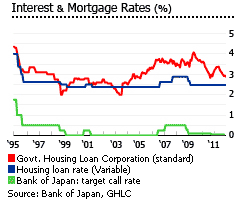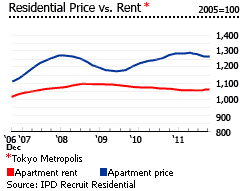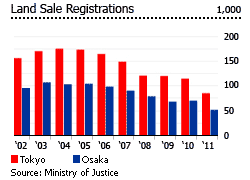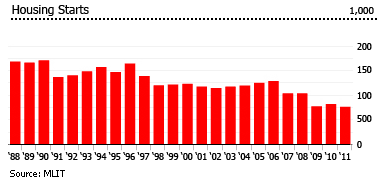Japanese house prices rising strongly!
After almost two years of house price falls, Japan’s housing market is now gaining momentum, mainly due to the economic policies of Prime Minister Shinzo Abe, who came to power in December 2012. These economic policies, which are now affectionately referred to as “Abenomics”, include increasing public infrastructure spending, devaluation of the yen and aggressive quantitative easing by the Bank of Japan (BOJ).
In Tokyo Metropolitan Area:- The average price of new condominium units soared by 9.2% y-o-y to JPY686,000 (US$6,931) per square metre (sq. m.) in June 2013, based on figures released by the Land Institute of Japan (LIJ).
- The average price of existing condominium units rose by 5.9% to JPY399,700 (US$4,039) per sq. m. during the year to June 2013.
- The average price of existing detached houses was up by 1.5% to JPY32,130,000 (US$324,644) over the same period.
In Osaka Metropolitan Area:
- The average price of new condominium units rose by 8.8% to JPY542,000 (US$5,476) per sq. m. during the year to June 2013.
- The average price of existing condominium units increased by 5% to JPY250,000 (US$2,526) per sq. m. over the same period.
- The average price of existing detached houses was down by just 0.5% to JPY20,000,000 (US$202,081) over the same period.
Land prices are also rising. During the year to June 2013, the average price of land in Tokyo Metropolitan Area rose by 5.2% to JPY204,500 (US$2,066) per sq. m., while in Osaka Metropolitan Area the average land price increased by 2.3% to JPY132,000 (US$1,334) per sq. m.
Residential construction activity is picking up. The number of new dwelling starts in Japan increased by 8.6% to 451,063 during the first half of 2013, compared to the same period last year, according to the Ministry of Land, Infrastructure, Transport and Tourism (MLIT).
Property sales are rising sharply. In Tokyo, the total number of condos sold rose 16.7% to 19,070 during the first half of 2013 compared to the same period last year, according to LIJ. In Osaka, the number of condos sold rose by 14.4% to 8,758 over the same period.
Total outstanding real estate loans in Japan increased 2.6% y-o-y to JPY444 trillion (US$44.86 trillion) in Q1 2013, according to the Bank of Japan
House prices are expected to continue to rising in the remaining months of 2013, according to local property experts. Moreover, Tokyo’s successful bid to host the 2020 Summer Olympics is expected to boost property demand and the construction sector during the next 7 years.
The international rating agency, Moody’s, has recently revised the outlook on the country’s real estate sector from negative to stable.
The Japanese economy grew by an annualized rate of 3.8% in Q1 and Q2 2013. The economy is expected to expand by about 2.8% for the whole year of 2013, up from a 2% in 2012 and a 0.6% contraction in 2011.
The lost decade

In fact, Japan is still recovering from the great asset bubble of the late 1980s. From 1970 to 1980, land prices in Japan rose 200% (23.5% in real terms), and 238.5% in the six major cities (39.3% in real terms). Then during the 1980s, there was a 103% increase nationally (61.6% in real terms) and a 272.2% rise in the six major cities (196.4% in real terms).
The 1991 crash left banks with bad loans of almost USD 1 trillion, contributing to Japan’s ‘lost decade’.

Japan’s super-strong financial system

Japan’s financial system is now in excellent shape. During Junichiro Koizumi’s prime ministership (2001 to 2006) tighter asset assessments of major banks caused a large decline in NPLs, from 8.7% of total loans in March 2002, to 1.4% in March 2008, according to the Financial Services Agency (FSA). Lending competition has also intensified, especially in metropolitan areas. Net result: housing loan costs have fallen.
Interest rates are “virtually zero”

The BOJ’s key interest rate has been “virtually zero” (0% - 0.1%) since October 2010, and below 1% since mid-1990s. Bank variable interest rates in Japan have hardly moved since 2000, remaining at 2.475% in December 2011.
Yet demand for loans remains weak, given the recent financial crisis, and the earthquake‘s impact. The ratio of outstanding home loans to GDP remains very much lower in Japan than in other developed countries, at around 24.5%.

Could a reason for lacklustre demand for housing loans be low rental returns? Global Property Guide research suggests that rental yields in Tokyo fell from an average of 5.5% in 2009, to 4.8% in 2011, findings consistent with trends shown in IPD-Recruit residential data (see chart below). However if Tokyo prices have been rising ahead of rents, weak loan demand is less likely to reflect a specific reluctance to buy versus rent, and more a general reluctance to spend on any kind of housing.

Hints of recovery

Japan was seriously affected by the global financial crisis in 2008 and 2009, and following that house prices fell by up to 4% nationally, and by almost 8% in the six major cities. However, Japan’s economy bounced back in 2010, and there were strong new condominium sales in Tokyo, with the number of dwelling units sold up 22.5%, according to the Real Estate Economic Institute. The increase was helped by the enhanced mortgage tax break carried over from 2009.
Property sales are now rising sharply. In Tokyo, the total number of condos sold rose 16.7% to 19,070 during the first half of 2013 compared to the same period last year, according to LIJ. In Osaka, the number of condos sold rose by 14.4% to 8,758 over the same period.

Residential construction activity is also picking up. The number of new dwelling starts in Japan increased by 8.6% to 451,063 during the first half of 2013, compared to the same period last year, according to the Ministry of Land, Infrastructure, Transport and Tourism (MLIT).
Bigger trade deficit, yen weakens
Because of Prime Minister Shinzo Abe’s efforts to correct the excessive appreciation of the yen, the domestic currency weaken sharply to JPY97.82 = US$1 in August 2013. Abe’s decision immediately reaped rewards when exports increased by 10.1% in May 2013 from the same period last year, the fastest annual rise since 2010, based on figures from the Ministry of Finance.

However, Japan’s trade deficit is growing, mainly due to the weaker yen and the country’s soaring energy import bill. In August 2013, the country’s trade deficit ballooned to JPY969.9 billion (US$9.8 billion).
Healthy economic growth in 2013

From 2000 to 2007, the Japanese economy grew by an average of 1.5% annually. However due to the global financial meltdown, the economy contracted by 1% in 2008 and by another 5.5% in 2009. The economy returned to growth in 2010 with real GDP growth of 4.7%. Then Japanese growth contracted again, shrinking by 0.6% in 2011 due to the impact of the Great Tohoku Earthquake (magnitude 9.0) last March 11, 2011. In addition the economic slowdown in China, Japan’s largest export market, exacerbated the situation. Then there’s the anti-Japanese feeling in China sparked by the dispute over Diaoyu/Senkaku Islands. In 2012, the economy had GDP growth of 2%.
The Japanese economy is projected to grow robustly in the coming years mainly due to the economic policies advocated by Prime Minister Shinzo Abe, who came into power in December 2012. These economic policies, which are now widely referred to as “Abenomics”, include the following:
- Inflation targeting at 2%
- Correction of the excessive appreciation of the yen
- Setting negative interest rates
- Radical quantitative easing
- Expansion of public investment
- Buying operations of construction bonds by Bank of Japan
- Revision of the Bank of Japan Act
Robert Feldman, head of Japan economic research at the Morgan Stanley, projects that the Olympic Games will add around 0.7% to 0.8% of GDP over 7 years.
“Our rough view is that the impact could be at least similar to the U.K. [host of the London 2012 Summer Olympics], at around 0.7-0.8 percent of GDP over 7 years, or about 3-4 trillion yen on a value added basis, or about 6-8 trillion yen on a gross output basis,” said Feldman.
The Japanese economy grew by an annualized rate of 3.8% in both Q1 and Q2 2013. The economy is expected to expand by about 2.8% for the whole year of 2013.
In July 2013, the nationwide annual inflation rate rose to 0.7% from a year earlier, its second consecutive month of gains and the largest increase in consumer prices in five years, mainly due to increased manufacturing. Consumer prices have continuously fallen in the past four years, with annual inflation rates of -1.3% in 2009, -0.7% in 2010, -0.3% in 2011 and -0.04% in 2012, according to the International Monetary Fund (IMF).
